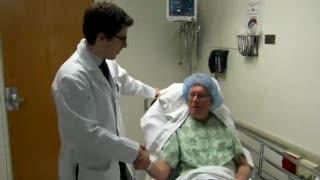"I'm 70, and with advanced age the hazards of surgery can increase, so I wanted the least invasive surgery possible," explained Mr. Carter. "The robotics provide more steadiness and precision, and I wanted my surgeon to be as steady and as precise as possible. It seems to me this is just a much wiser system."
How does it work? The Firefly technology uses near-infrared imaging to detect an injected tracer dye of indocyanine green (ICG) in the blood.
During surgery, urologists use the Firefly system at three different stages of the procedure. The first injection of the dye into the IV by the anesthesiologist gives a detailed picture of the blood supply to the kidney.
"Up to 25-percent of patients might have extra renal arteries that are not always obvious on a CT scan or MRI, so the Firefly can help us see these arteries. This helps us ensure that all of the blood supply to the kidney is accounted for and controlled prior to the removal of the tumor, and can therefore decrease blood loss," explained Dr. Kowalczyk.
The second injection of dye helps the surgeon differentiate between the cancerous tissue and the normal kidney tissue, which can allow for better tumor removal and potentially a lower risk of leaving any cancer behind. Finally, after the tumor has been removed and the kidney has been repaired, the dye can again be injected again to ensure that the blood supply to the kidney has been properly restored.
Besides the known benefits of robotic minimally-invasive surgery—including smaller incisions, less blood loss, less postoperative pain, shorter hospital stays, and earlier returns to work—the addition of the Firefly system can improve patient outcomes even further.
"Additionally, the ability to better distinguish between tumor tissue and normal kidney tissue may lead to a lower risk of leaving any tumor behind, and therefore better long-term cancer control," said Dr. Kowalczyk.
According to the American Cancer Society, kidney cancer is among the 10 most common cancers among both men and women. The ACS estimates that about 64,770 new cases of kidney cancer will occur in 2012, and about 13,570 people will die from the disease.
"I'm so glad I was able to keep my kidney," said Mr. Carter. "Without this new system, my kidney might not have been able to be saved."

Keith Kowalczyk, M.D., performs kidney surgery using Firefly fluorescence with da Vinci Surgical System to remove just the kidney tumor while sparing healthy tissue. Firefly lights up the blood supply and then the kidney in "firefly green."
(Photo Credit: MedStar Georgetown University Hospital)

Keith Kowalczyk, M.D., uses Firefly fluorescence technology with the Da Vinci Robotic System to spare healthy kidney tissue when removing cancerous kidney tumors.
(Photo Credit: MedStar Georgetown University Hospital)